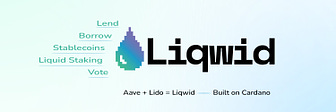Liqwid Labs
About Liqwid Labs:
Liqwid
Liqwid is an interest rate curve DeFi liquidity protocol for the Cardano ecosystem. It establishes a decentralized marketplace for lenders and borrowers to seamlessly interact via supplying funds, minting interest-bearing qTokens, borrowing assets and participating in governance.
The solution is built on the Cardano UTXO model for deterministic, secure, and low-cost transactions. The Liqwid Protocol is built to enable any liquidity provider or user to access interest and liquidity on-demand and for developers to unlock a web3-verse of open financial applications.
- Supply: Liqwid establishes decentralized money markets via smart contracts to enable lenders to automatically earn the prevailing supply rate and developers to build interest directly into their product. Balances held within the protocol can earn interest based on the market demand for that asset. Interest is earned by the block and can be used as collateral to borrow assets.
- Borrow: Use your qToken collateral to borrow from the Liqwid Protocol instantly with no trading fees, no slippage and directly on the Cardano blockchain. With Liqwid you gain on-demand access to a global interest rate curve liquidity pool directly on-chain.
- Token: Liqwid interest bearing tokens (qTokens for short) are minted upon supplying and burned when users withdraw funds. The qTokens are pegged 1:1 to the value of the underlying asset supplied to Liqwid protocol. By minting qTokens, users earn interest through the qToken's exchange rate, which continuously increases in value relative to the underlying asset and can use qTokens as collateral. While the underlying asset is loaned out to borrowers, qTokens accrue interest in real time, directly in your Cardano wallet.
- Governance: Liqwid is managed by a decentralized community of LQ token-holders and their delegates, who propose and vote on upgrades to the protocol or request project funding from the LiqwiDAO Treasury. Participate in governance to develop the future of the Liqwid Protocol, all based on $LQ.
Disclaimer: Due to volatility in the crypto market, be sure to have an understanding of health scores and how they work in order to avoid liquidation. If your health score falls below 1, your collateral will be forfeited.
Below is a hyperlink to a free 6-minute tutorial created by the Liqwid Labs team, it's very clear and concise, we highly recommend that you take a look if you will be participating in any lending & borrowing on the Cardano blockchain. Enjoy!
https://www.youtube.com/watch?v=Zs9eKlxpyvQ


